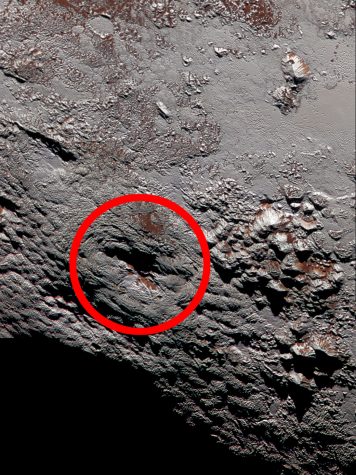NASA Scientist gives seminar on satellite fly-by of Pluto
April 13, 2016
Pluto is a vastly different planet from anything any space agency on Earth has ever studied. It is the next line in astronomical study, and scientists are uncovering new data from the visual and spectral imaging taken of it from its New Horizon satellite fly-by every day.
NASA Deputy Project Scientist Kimberly Ennico-Smith visited the College of DuPage this past Sunday, April 10, where she discussed the results from the first fly-by of the dwarf planet Pluto to a packed crowd at the Belushi Theater in the McAnnich Arts Center. The fly-by took place late last year, and pictures taken have revealed a plethora of new data about the planet’s composition.
Ennico-Smith has been a deputy project scientist for the New Horizons mission for the past four years. She has learned a lot about Pluto after knowing almost nothing about the planet when she joined the team.
“I knew nothing about Pluto going in,” said Ennico-Smith. “I was there primarily to calibrate the instruments prior to the Pluto fly-by, which I did. Also doing the post-Pluto calibration, and the science, which I hadn’t expected to do but it’s been a joy to be part of that team.”
Ennico-Smith believes her experience with past projects and her passion towards the position was what landed her the role on the mission.
“Allen Stern, the principle investigator of New Horizons, saw my work and other projects and knew that was one of the things I want to do in my career is to be a project scientist,” said Ennico-Smith. “It’s a role that I hadn’t had before. It’s a role where you talk to scientists and engineers and you bridge that as parts of the mission. He offered me a deputy project scientist role, and I jumped at the chance.”
Curator of the event and COD astronomy professor Joe DelSanto believes that these new findings are the start of the next in-depth wave of study of our solar system.
“This is a whole new type of body that we have never been able to explore before,” said DelSanto. “There’s a large number of these in our solar system, and this was a first look at one of these new bodies from the outer solar system. It’s what they call the third zone, so to speak, of the solar system. It’s a whole new region of the solar system to explore, and by exploring that it helps understand the whole solar system better, rather than just part of it.”
There are two zones of our solar system before Pluto’s third zone. The first zone holds the terrestrial, rocky planets behind the asteroid belt, the large ring of rocks orbiting the sun between Mars and Jupiter. From Jupiter to Neptune are the Jovian planets, which are the gaseous giants made of miscellaneous gases, such as methane and nitrogen. Past Neptune is a belt of comets, or large ice satellites, called the Kuiper Belt. This is where Pluto and other dwarf planets are stationed.
These planets in the Kuiper Belt bring forth a new set of planets to study due to their terrestrial composition and distance from the sun. With these pictures taken by the New Horizons satellite, scientists were able to detect large glaciers of water, methane and nitrogen ice. As well, they have theorized that there is active geological activity on the dwarf planet through finding what looks to be cryovolcanoes and possible heat convection under the surface of the planet.

As seen in Figure 1, the area within a red circle is believed to be a cryovolcano, which is a volcano that erupts water, nitrogen and methane ice instead of molten rock like on Earth.
Ennico-Smith has been the deputy projects director for the New Horizons NASA mission for the past four years, and had a hand in tweaking the satellite’s trajectory to reach its destination and take the new images of Pluto.
“This is the first time we’ve spent a spacecraft to an object of this type,” said Ennico-Smith. “This binary type planet system of Pluto and Charon with these smaller moons are like nothing else in the solar system, or we know of anywhere else. It had always been a mysterious place, because it has been changing over the past several decades that they have been observing it from the ground. So it has been a lot of unexpected discoveries. The awesomeness about the fly-by in 2015 in the information age and the digital age is that we can share what the scientists are seeing with the world in real time, which is unprecedented. “
Ennico-Smith talked about how Pluto’s moons and orbit is nothing like anything we’ve seen with the eight planets. Pluto has a sideways axis like Uranus, where instead of spinning horizontally like Earth the planet rotates vertically. Due to this, the planet’s surface and moons act differently than they would with most planets in our solar system.
The moons rotate around the planet’s axis, just like on Earth. This makes the moon’s orbit around the planet look like a bullseye, in which moons orbit what we would see on Earth as the north and south sides of the planet. The planet’s horizontal axis also makes the planet’s surface vastly different.
Where on earth each side of the planet receives 12 hours of sunlight at a time, each side of Pluto receives decades of sunlight. This is because the only factor that changes the amount of sunlight on one side of the planet is its orbit around the sun, due to Pluto’s 247.7 Earth-year long orbit around the sun.
Ennico-Smith encourages people that are interested in what NASA has uncovered with the New Horizon fly-by to google “New Horizons Pluto” to find their weekly updates on what they are uncovering about the distant planet.

















